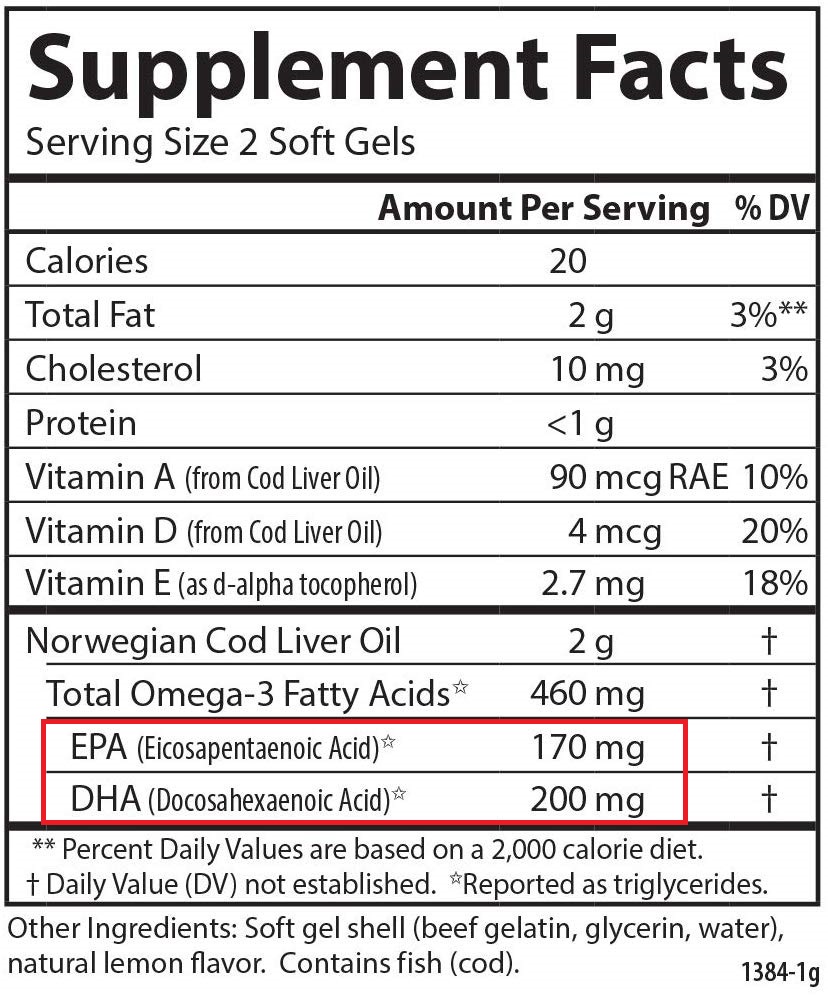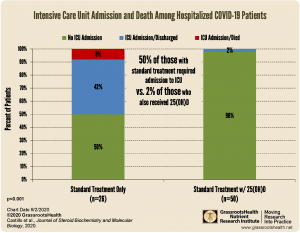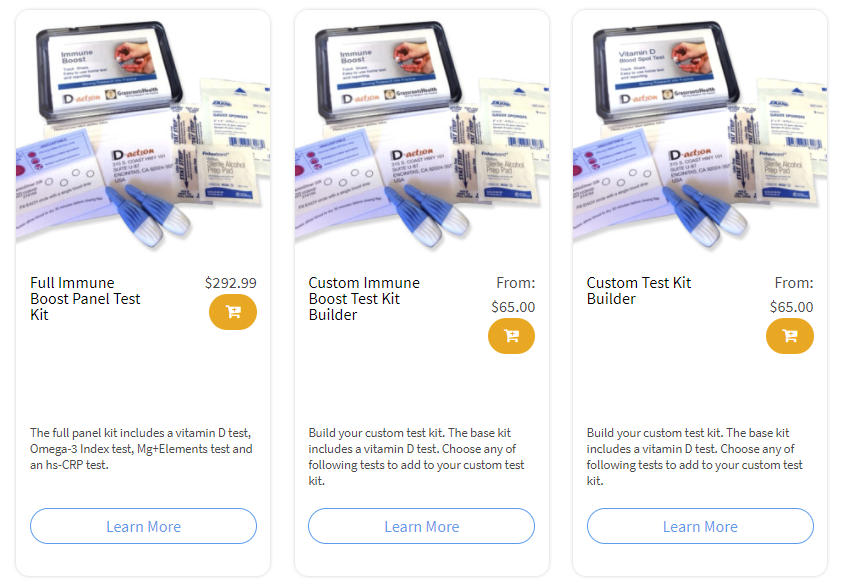Published on October 29, 2020
How to read a supplement label: Omega-3s
In a previous post we discussed the importance of paying attention to the serving size and suggested directions for use to ensure that you get the nutrients you expect from the supplements you are taking. We also previously looked at the information that is important on vitamin K, magnesium, vitamin E, and vitamin A labels. In today’s post we will look at the information on Omega-3 supplement labels.
What are Omega-3s?
 Omega-3 fatty acids are a healthy type of fat that comes in multiple forms. Long-chain omega-3s, primarily eicosapentaenoic acid (EPA) and docosahexaenoic acid (DHA), have been linked to numerous cardiovascular health benefits such as reducing triglycerides, lowering blood pressure, raising HDL-cholesterol, and reducing inflammation. EPA and DHA have also been associated with a reduced risk of anxiety and depression, cancer, asthma, Alzheimer’s disease, type 1 diabetes, multiple sclerosis, and total mortality. Children of women who consume EPA and DHA during pregnancy and nursing have better neurological developmental and other health outcomes. Evidence also suggests that intake of EPA and DHA can help treat symptoms of dry eye disease, lupus, and rheumatoid arthritis.
Omega-3 fatty acids are a healthy type of fat that comes in multiple forms. Long-chain omega-3s, primarily eicosapentaenoic acid (EPA) and docosahexaenoic acid (DHA), have been linked to numerous cardiovascular health benefits such as reducing triglycerides, lowering blood pressure, raising HDL-cholesterol, and reducing inflammation. EPA and DHA have also been associated with a reduced risk of anxiety and depression, cancer, asthma, Alzheimer’s disease, type 1 diabetes, multiple sclerosis, and total mortality. Children of women who consume EPA and DHA during pregnancy and nursing have better neurological developmental and other health outcomes. Evidence also suggests that intake of EPA and DHA can help treat symptoms of dry eye disease, lupus, and rheumatoid arthritis.
The primary food source of EPA and DHA is fatty fish such as salmon, mackerel, herring, sardines, and tuna. Plant oils, such as flaxseed and soybean, contain alpha-linolenic acid (ALA), another omega-3 form that can be converted to EPA and DHA, but the conversion rate is very low. Additionally, there are hundreds of dietary supplements available to the public that contain EPA and DHA.
How do Omega-3s appear on supplement labels?
Omega-3s (EPA and DHA) are primarily found in stand-alone supplements but can also be found in some multivitamins. Formulations for these supplements vary widely in the amount of EPA and DHA as well as in the type of oil and form of omega-3 fatty acid. The most common oil types are fish oil (including cod liver oil and salmon oil) and krill oil, but supplements with EPA and DHA can also contain algal oil, calamari oil, or other marine-based oils. The form of omega-3 fatty acid can also differ between products. For example, krill oils consist of phospholipids whereas fish oils can consist of ethyl esters or triglycerides.
Most supplements list the amount and type of oil on their nutrition label and many also list the amount of total omega-3s, EPA & DHA combined, and/or EPA and DHA individually. On the example nutrition label below, the amount of EPA is 170 mg and the amount of DHA is 200 mg per serving of 2 soft gels, totaling 370 mg of EPA+DHA. It is important to note that this is NOT equivalent to the amount of cod liver oil (2 g) nor the amount of total omega-3 fatty acids (460 mg) listed on the label, which are often the numbers advertised on the front of the product (and higher than the amount of EPA+DHA so without careful inspection, you may think you are getting more than you actually are).
Our recently published analysis found that approximately 1,300 mg per day of combined EPA & DHA was needed for 50% of the population to achieve an Omega-3 Index of 8% which is considered optimal for health (~1,900 mg per day was needed for 90% of the population).

Following the “directions” on supplement labels is also important. For the example supplement above, the directions (not shown on the picture) say “take two soft gels once daily at mealtime.” Taking omega-3 supplements with a fatty meal is important for maximum absorption of many fish oil supplements. Krill oil supplements and triglyceride-based fish oils do not need to be consumed with a fatty meal because they contain phospholipids which aid absorption.
Among GrassrootsHealth participants who have previously reported their supplemental intake, 65% reported taking an omega-3 supplement. We appreciate you taking the time to enter your supplemental omega-3 intake in the questionnaire!
Are You Getting Enough Omega-3s?
GrassrootsHealth offers several testing options to help measure the status of omega-3 and omega-6 fatty acids – the Omega-3 Index, AA:EPA Ratio, and Omega-6:Omega-3 Ratio. Learn more about these tests and the differences between them here. More information on how to improve these test results can be found here.
Using the GrassrootsHealth Custom Kit Builder, you can create a test kit that measures the status of important nutrients (such as vitamin D, omega-3s, and magnesium), as well as your CRP level. Click here to build and order your test kit today – measure your status and take the steps necessary to improve them if needed; make an impact on your health today and for your future! When you know what your levels are, you can determine next steps to take and how much supplementation may be needed if you are not at your target levels.
Concerned specifically about your immune health? See if your immune system might be needing more vitamin D and other immune boosting nutrients by enrolling in the Immune Boost Project with the Full Immune Boost Panel (which includes tests for vitamin D, Omega-3 Index, magnesium, zinc, selenium, copper, and hsCRP), and get 10% off when you use coupon code BoostTen at checkout.
What Does it Take YOU to Get Your D to 40 ng/ml (100 nmol/L)?
Did you know your health could be greatly affected by making sure you have a vitamin D level of at least 40 ng/ml (100 nmol/L)? Help us help you.
STEP 1 – Do you know what your vitamin D level is? If not, be sure to test today to find out.
STEP 2 – Determine your target level. Are you at your target level? Experts recommend a level of at least 40-60 ng/ml (100-150 nmol/L).
STEP 3 – Need to boost your level? Use the D*calculator to see how much vitamin D it may take to reach your target. Opt for the Loading Dose for a quicker boost.
STEP 4 – Optimize how your body absorbs and utilizes vitamin D with co-nutrients and these simple steps.
STEP 5 – Re-Test! This is an important step to make sure you have reached your target level, and to ensure you are not taking too much! Re-testing after 3-4 months is recommended.
STEP 6 – Adjust, Repeat…
Give your immune system the nutrients it needs to support a healthy you and protect yourself from unnecessary diseases, especially COVID-19.
NEWS ALERT
 The first Randomized Controlled Trial on vitamin D and COVID-19 has shown a 96% lower risk of ICU admission for those receiving vitamin D (as 25(OH)D to quickly boost vitamin D blood levels) along with the standard treatment, compared to those receiving standard treatment alone.
The first Randomized Controlled Trial on vitamin D and COVID-19 has shown a 96% lower risk of ICU admission for those receiving vitamin D (as 25(OH)D to quickly boost vitamin D blood levels) along with the standard treatment, compared to those receiving standard treatment alone.
These results support many previous observational studies showing a relationship between vitamin D levels and intake and COVID-19 severity.
Review the Latest Nutrient Research for COVID-19
GrassrootsHealth Nutrient Research Institute has launched the new Immune Boost project with the use of our myData-myAnswers nutrient health system that nearly 15,000 people are already using for their health. Specific markers that influence immune health are suggested for testing as part of this project including:
- Vitamin D
- Omega-3 Index
- Essential elements magnesium, selenium, and zinc
- hsCRP
Our goal is to demonstrate how one can use the Nutrient Research Model established by Dr. Robert Heaney to show the effect of vitamin D serum levels of at least 40 ng/ml (100 nmol/L) on risk reduction for all ethnicities in the population. Status and intake of other nutrients will also be analyzed for any type of relationship to immune status and symptom severity. Join the project today!
Please let us know if you’re interested in helping sponsor this project.
Through GrassrootsHealth Nutrient Research Institute, you can also test your essential elements magnesium, copper, zinc and selenium, toxins such as lead, mercury and cadmium, as well as your omega-3 levels, inflammation levels and thyroid stimulating hormone (TSH) level. Find out your levels today! Log on to the test selection page (click the link below) to get your tests and see for yourself if your levels can be improved.
Make sure you track your results before and after, about every 6 months!
Click Here to Access the Test Page
How can I track my nutrient intake and levels over time?
To help you track your supplement use and nutrient levels, GrassrootsHealth has created the Personal Health Nutrient Decision System called
For each specific supplement, you can track what days you take it, how much, and many other details. This will help you know your true supplemental intake and what patterns of use work for you to reach and maintain optimum nutrient levels. Check it out today!









